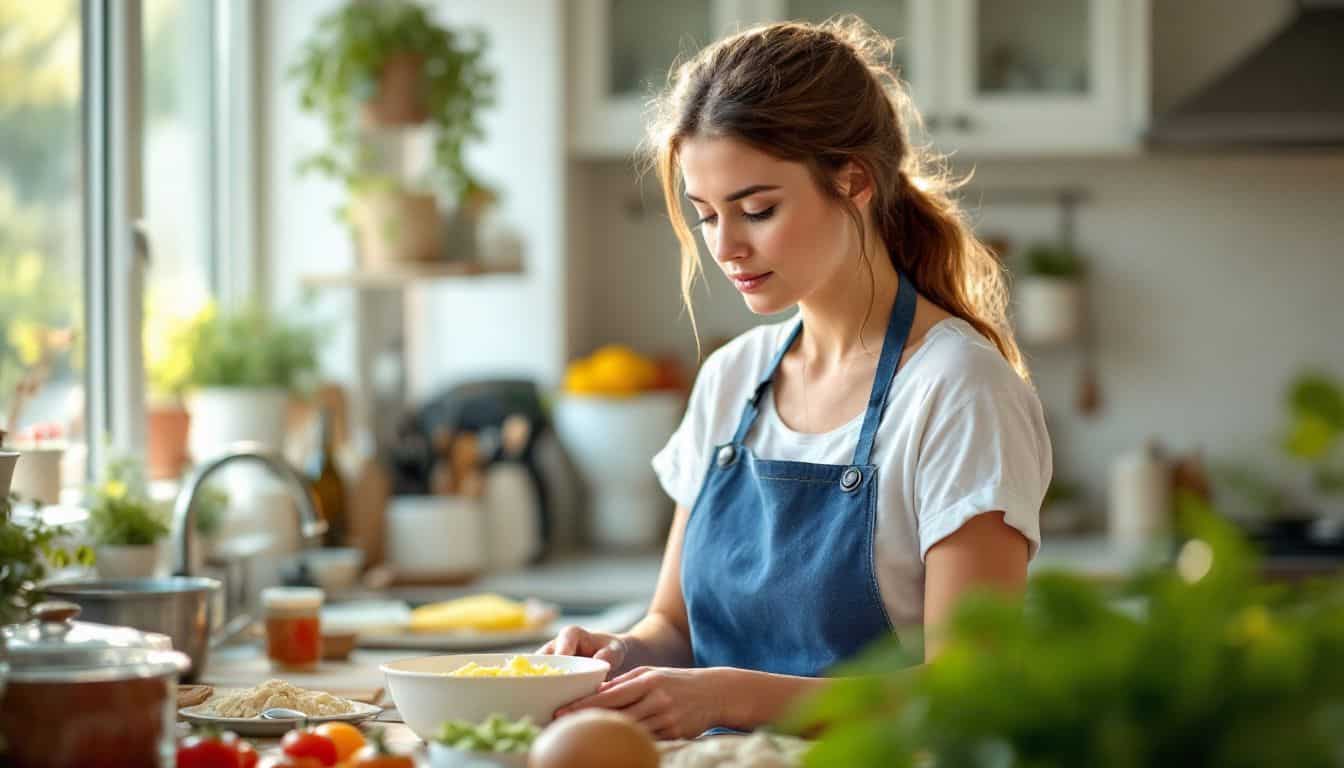Are you tired of eating takeout every night? Learning to cook can change your life. It’s a skill that saves money and helps you eat better. This guide will show you how to learn how to cook in 9 easy steps.
Get ready to become a kitchen pro!
Key Takeaways
Start with basic cooking tools like sharp knives, pots and pans, and measuring cups. Stock your pantry with essentials like oils, spices, and canned goods.
Master fundamental techniques like boiling, sautéing, and roasting. Practice with simple recipes like scrambled eggs, roasted vegetables, and pasta dishes.
Read recipes carefully before cooking and prep ingredients ahead of time (mise en place). Use proper seasoning techniques and avoid common errors like overcrowding the pan.
Explore world cuisines and try advanced techniques like sous vide cooking to expand your skills. Use cookbooks, online classes, and video tutorials to keep learning.
Follow food safety rules like washing hands often and keeping raw meats separate. Start with easy cooking projects and work up to more complex multi-course meals.
Table of Contents
Essential Cooking Tools and Ingredients for Beginners

Ready to start cooking? Let’s talk tools and ingredients. You’ll need some basic gear and pantry staples to get going.
Basic Cooking Utensils and Equipment
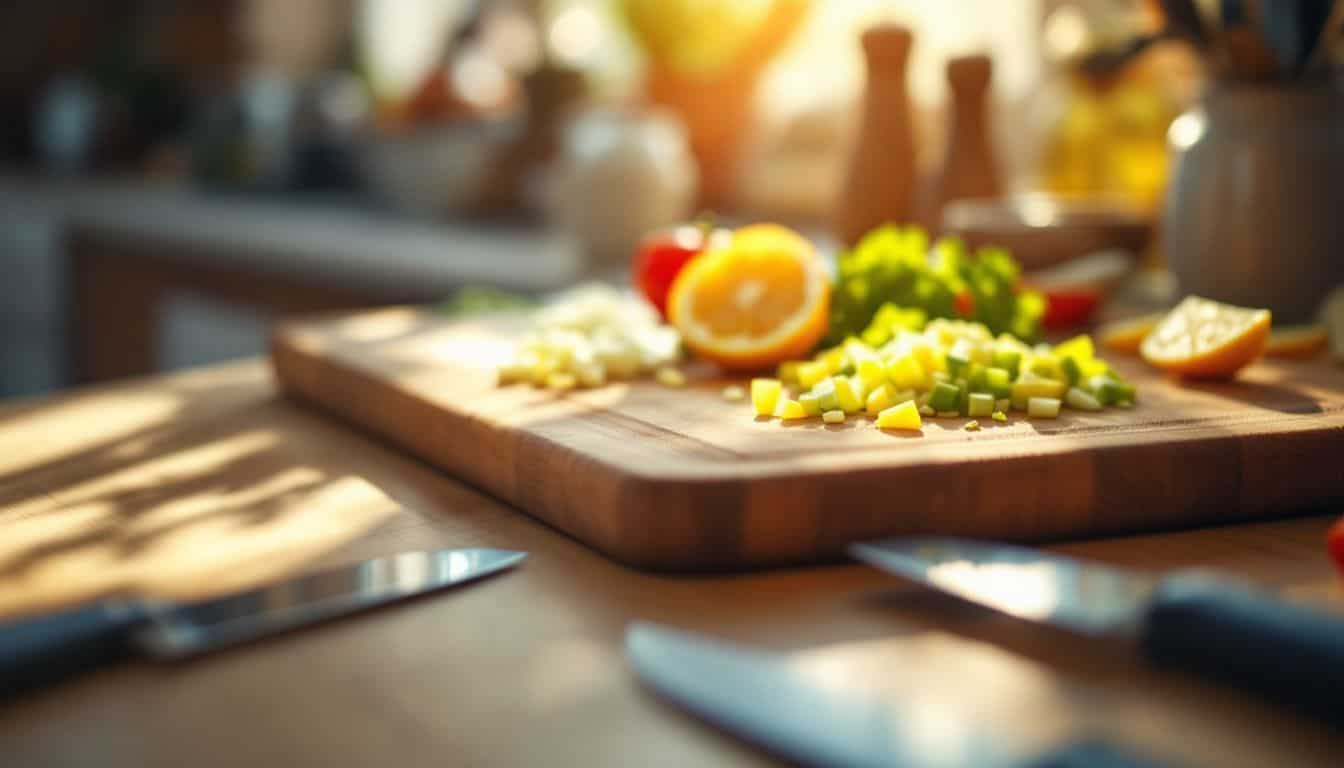
Guys, let’s talk kitchen gear. You don’t need a ton of fancy stuff to whip up great meals. Here’s what you really need to get cooking:
- Knives: Get three good ones – a chef’s knife for chopping, a paring knife for small jobs, and a serrated knife for bread. Sharp knives make cooking way easier and safer.
- Cutting board: Wood or plastic works best. Skip glass or stone – they’ll dull your knives fast. A good board gives you a stable surface for all your slicing and dicing.
- Pots and pans: Start with a stock pot, sauté pan, skillet, and saucepan. Non-stick pans are great for beginners. These basics let you boil, fry, simmer, and more.
- Baking sheets: Get a couple. They’re not just for cookies – use them for roasting veggies or baking chicken too.
- Measuring tools: Grab some cups and spoons. Cooking is part science, and these help you nail recipes every time.
- Mixing bowls: A set of different sizes comes in handy. Use them for tossing salads, mixing batters, or marinating meats.
- Colander: Perfect for draining pasta or washing fruits and veggies. It’s a simple tool you’ll use all the time.
- Utensils: Stock up on spatulas, whisks, and wooden spoons. These are your go-to tools for stirring, flipping, and mixing.
- Can opener: Unless you want to fight with cans, get a good one. It’ll save you time and frustration.
- Storage containers: Great for leftovers or meal prep. They help keep your fridge organized and your food fresh.
With these basics, you’re set to cook gourmet meals in your backyard or kitchen. Start simple, and you’ll be whipping up tasty dishes in no time.
Key Pantry Staples for New Cooks

Now that you’ve got your basic tools, let’s stock your pantry. Having these key items on hand will make cooking a breeze.
- Oils and fats: Keep olive oil, vegetable oil, and butter. These are your cooking foundations.
- Salt and pepper: Kosher or sea salt, and whole peppercorns with a grinder. They’re the basic seasoning duo.
- Dried herbs and spices: Start with garlic powder, onion powder, oregano, paprika, and cumin. They’ll add flavor to any dish.
- Vinegars: Apple cider and balsamic vinegars are versatile for dressings and marinades.
- Canned goods: Tomatoes, beans, and tuna are great for quick meals.
- Grains and pasta: Rice, quinoa, and various pasta shapes give you a solid base for many dishes.
- Broths: Chicken and vegetable broths are key for soups and sauces.
- Aromatics: Onions and garlic last long and add depth to your cooking.
- Condiments: Soy sauce, hot sauce, and mustard can jazz up any meal.
- Baking essentials: Flour, sugar, and baking powder for when you want to try your hand at baking.
Mastering Fundamental Cooking Techniques
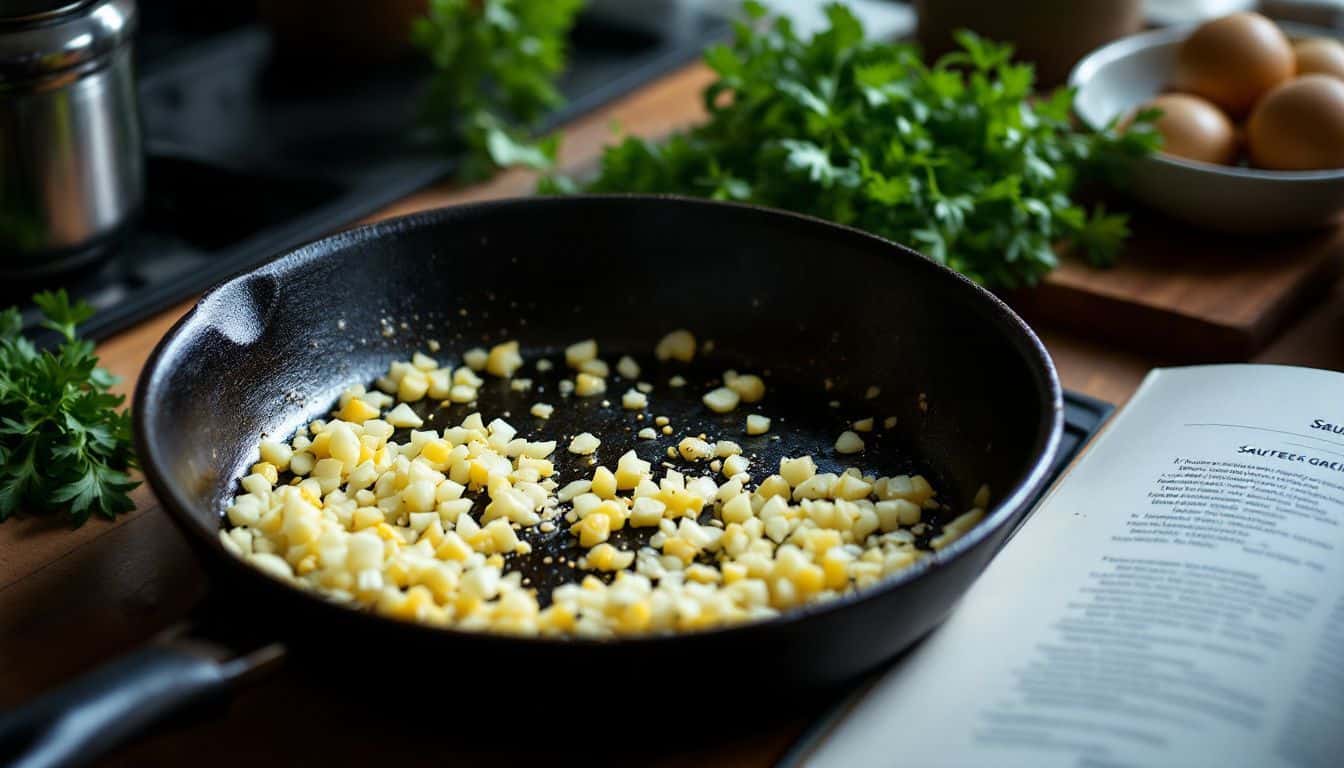
Ready to cook like a pro? Let’s dive into the basics. You’ll learn to sauté, braise, and grill like a champ – no sweat!
Learn Different Cooking Methods
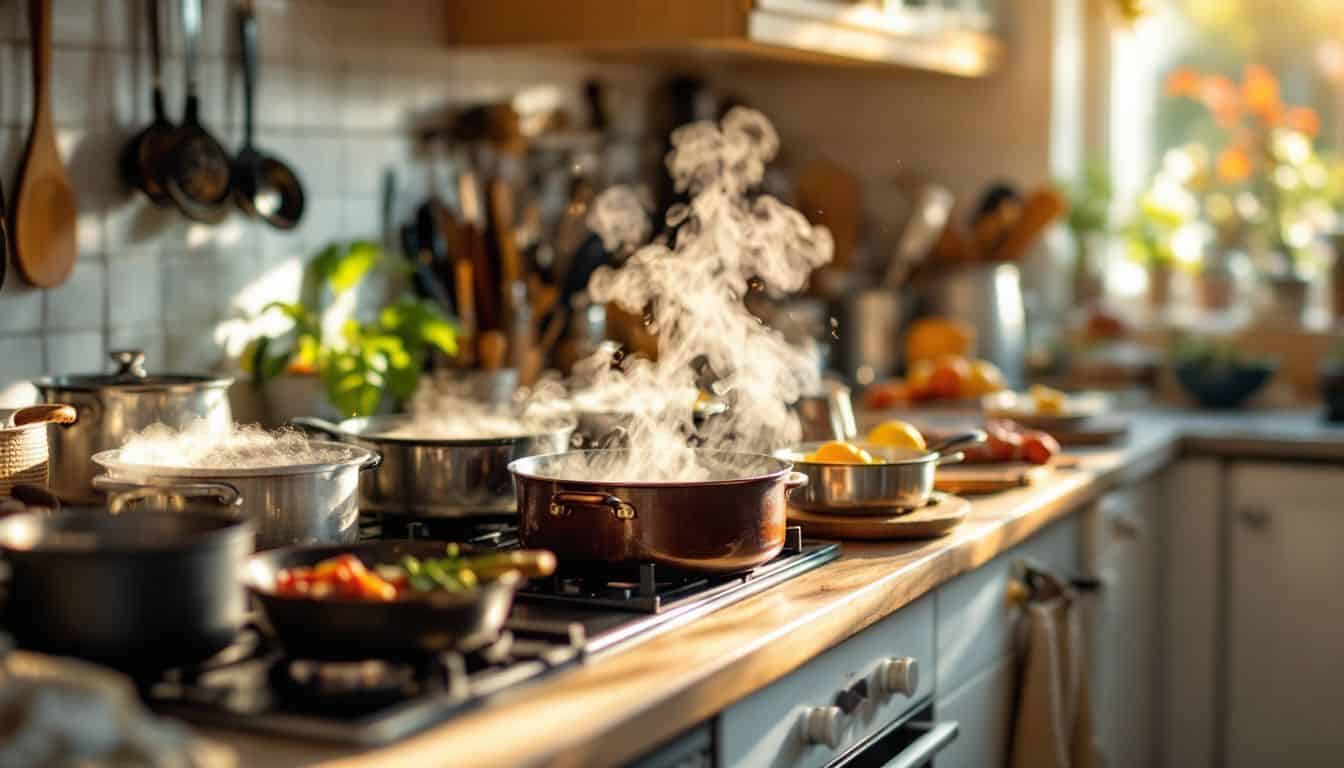
Mastering different cooking methods is key to becoming a kitchen pro. Let’s dive into some basic techniques that’ll up your culinary game.
- Boiling: Heat water to 212°F. Great for pasta, veggies, and eggs. Just toss ’em in and wait!
- Simmering: Keep liquid between 180°F-200°F. Perfect for soups and sauces. It’s like a gentle hot tub for your food.
- Poaching: Use 160°F-180°F liquid. Ideal for delicate foods like fish or eggs. Think of it as a spa day for your ingredients.
- Grilling: Apply direct heat up to 500°F. Awesome for meats and veggies. It’s like giving your food a nice tan.
- Broiling: Use high heat from above. Great for quick cooking and browning. It’s like a sun lamp for your dinner.
- Sautéing: Cook food quickly in a hot pan with oil. Perfect for stir-fries and quick meals. It’s the fast and furious of cooking methods.
- Braising: Slow-cook in liquid. Ideal for tough meats. It’s like a long, relaxing bath for your food.
- Steaming: Cook food with hot vapor. Great for veggies and dumplings. It’s like a steam room for your eats.
- Roasting: Cook food in dry heat. Perfect for meats and root veggies. It’s like giving your food a warm hug.
Practice Basic Recipes

Let’s explore some basic recipes to start your cooking journey. These simple dishes will help you build confidence and master key techniques in the kitchen.
- Scrambled eggs: Start with this classic breakfast. Crack eggs into a bowl, whisk them up, and cook in a non-stick pan over low heat. Stir gently until they’re creamy and set.
- Roasted vegetables: Chop up your favorite veggies, toss with oil and salt, and roast in the oven. It’s an easy way to learn about seasoning and cooking times.
- Stir-fry: Heat oil in a wok or large pan. Add some chopped veggies and protein. Keep it moving until everything’s cooked through. It’s quick, tasty, and teaches you about high-heat cooking.
- Pasta with tomato sauce: Boil pasta, drain it, and mix with store-bought sauce. As you get comfortable, try making your own sauce with canned tomatoes, garlic, and herbs.
- Grilled cheese: Butter bread, add cheese, and cook in a pan until golden brown. It’s simple but teaches you about heat control and timing.
- Rice: Learn this staple food. Rinse rice, add water, bring to a boil, then simmer until fluffy. It’s a great side for many dishes.
- Fried rice: Use leftover rice to make this tasty meal. Sauté veggies and protein, add rice, and season with soy sauce. It’s a great way to use up leftovers and practice stir-frying.
- Simple salad: Chop lettuce, add veggies, and toss with a basic dressing. It’s an easy intro to knife skills and balancing flavors.
- Pancakes: Mix flour, eggs, milk, and a bit of sugar. Cook on a griddle until bubbles form, then flip. It’s a fun weekend project that teaches you about batter consistency.
- Baked chicken: Season chicken breasts with salt, pepper, and herbs. Bake in the oven until cooked through. It’s an easy way to learn about cooking meat safely.
Cooking is all about practice. Don’t worry if things aren’t perfect at first. Keep at it, and soon you’ll be whipping up meals like a pro. For quick, easy protein boosts between meals, check out these top high-protein snacks.
How to Read and Follow Recipes

Cooking can be challenging. But don’t worry – with some practice, you’ll be making meals like an expert soon. Just take it slow, read everything twice, and keep your measuring cups close by!
Decode Recipe Instructions and Abbreviations
Recipe instructions can look like a foreign language at first. But don’t sweat it! Start by reading the whole recipe before you cook. This helps you get the big picture. Look for words like “dice,” “sauté,” or “simmer.” These are cooking actions you’ll need to know.
Abbreviations in recipes are shortcuts. “Tbsp” means tablespoon, while “tsp” is teaspoon. “C” stands for cup, and “oz” is ounce. Keep a conversion chart handy – it’s a lifesaver when you’re in a pinch.
Here’s a pro tip:
Extract the key steps and condense them. It makes any recipe easier to follow.
Next up, let’s talk about planning your ingredients ahead of time.
Plan and Prepare Ingredients Ahead (Mise en Place)
Get ready to cook like a pro! Mise en place is your secret weapon. It’s French for “everything in its place.” Before you start cooking, gather all your tools and ingredients. Chop veggies, measure spices, and prep anything else the recipe calls for.
This simple step will save you time and stress in the kitchen.
I learned this trick from a chef friend. He showed me how to set up my workspace like a real kitchen pro. Now, I never start cooking without doing my mise en place first. It’s a game-changer! You’ll feel more confident and in control.
Plus, you’re less likely to forget an ingredient or mess up the timing. Give it a try – your taste buds will thank you!
Avoiding Common Cooking Errors
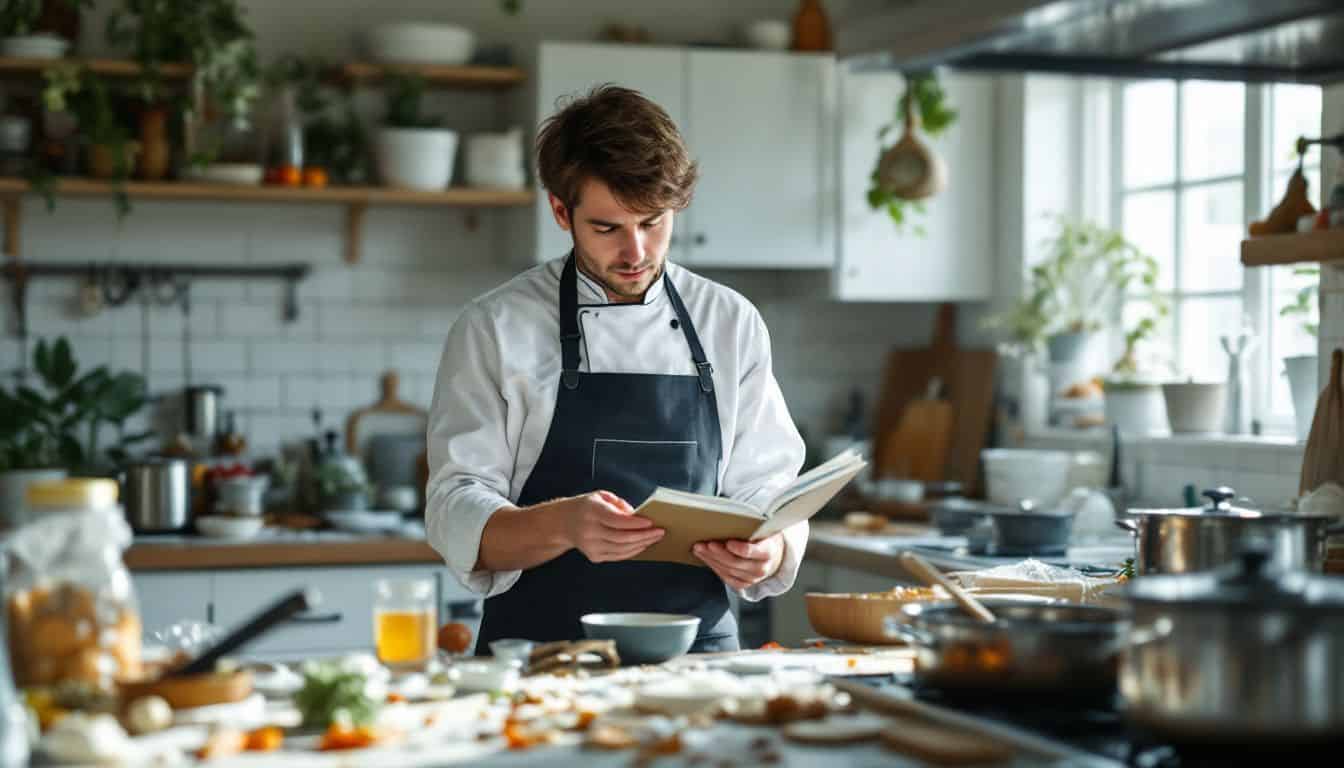
Cooking blunders can turn a tasty meal into a disaster. Let’s tackle some common slip-ups and learn how to dodge ’em – your taste buds will thank you!
Correct Cooking Timing Mistakes
Timing is key in cooking. Overcooking can turn a juicy steak into shoe leather. Undercooking might leave you with raw chicken – not good! To fix timing issues, use a timer and check food often.
Don’t trust recipes blindly. They’re guides, not gospel. Your oven or stove may run hotter or cooler than the recipe writer’s.
For meats, a meat thermometer is your best friend. Chicken should hit 165°F inside. Let cooked meats rest 5–7 minutes before cutting. This keeps the juices in. For veggies, learn to test doneness with a fork.
They should be tender but not mushy. Keep in mind:
Cooking is like love. It should be entered into with abandon or not at all. – Harriet Van Horne
Practice makes perfect. Soon, you’ll nail the timing every time.
Solve Overcrowding in the Pan
Guys, let’s talk about a common cooking mistake: cramming too much food in one pan. It’s like trying to fit your whole squad into a tiny car – it just doesn’t work. Overcrowding messes up your meal’s quality.
The fix? Easy. Keep at least an inch of space between food pieces. This lets heat circulate and cooks everything evenly. If you’re cooking for a crowd, don’t be afraid to use multiple pans or baking sheets.
Think of your pan like a dance floor. You wouldn’t want it so packed that nobody can move, right? Same goes for your food. Give those ingredients room to groove. They’ll brown better, cook faster, and taste amazing.
Plus, you’ll look like a pro in the kitchen. So spread out those veggies, space out that chicken, and let your food breathe. Your taste buds will thank you.
Learn Proper Seasoning Techniques
Seasoning is key to tasty food. It’s not just about salt and pepper. You’ve got herbs, spices, sweet stuff, and sour things too. The trick? Know when to add them. For slow-cooked meals, season early.
For most other dishes, wait till the end. Here’s a pro tip: taste your food at the temp you’ll serve it. Flavors can change when food cools down.
Don’t be shy with seasoning. Start small and add more as you go. Taste often. It’s better to under-season than over-do it. You can always add more, but you can’t take it out. And hey, don’t forget about acid.
A squeeze of lemon or a splash of vinegar can make flavors pop. It’s all about balance. Play around and find what works for you.
Advance Your Cooking Skills
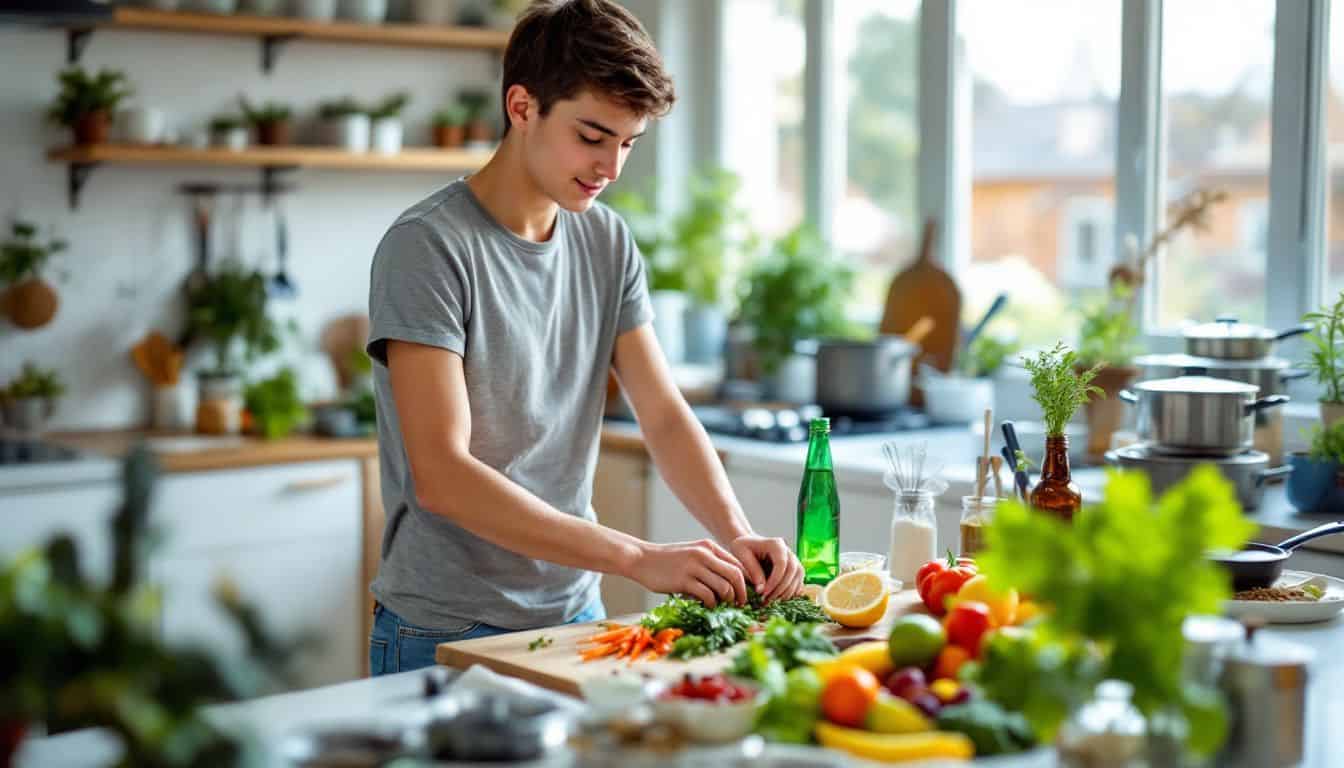
Ready to kick it up a notch? Let’s explore some cool ways to level up your cooking game. You’ll discover new flavors and techniques that’ll make your meals pop!
Explore World Cuisines
Exploring world cuisines is like taking a tasty trip around the globe. You’ll pick up new tricks and find cool ingredients to spice up your meals. I once tried making sushi at home – what a fun mess! But it taught me how to roll and slice carefully.
Each culture’s food has its own special flair. Italian dishes use lots of tomatoes and herbs. Indian food brings the heat with spicy curries. Chinese cooking is all about quick stir-fries in a hot wok.
Food is our common ground, a universal experience. – James Beard
Trying new recipes from far-off places can really boost your cooking skills. You might discover you love using a mortar and pestle to grind spices. Or maybe you’ll get hooked on making perfect rice.
The best part? Your taste buds get to go on an adventure too! Next up, let’s look at some great ways to improve your cooking game even more.
Try Advanced Cooking Techniques
Ready to level up your cooking game? Let’s dive into some advanced techniques that’ll make you feel like a pro in the kitchen.
- Anti-griddle magic: This cool gadget flash freezes food in under 90 seconds. Try it with sauces or purees for a fun twist on desserts.
- Sous vide mastery: Seal food in plastic bags and cook in simmering water. It’s perfect for getting that steak just right, every time.
- Molecular gastronomy: Play with food textures using chemicals. Turn liquids into caviar-like balls or make edible foams.
- Smoking indoors: Use a handheld smoker to add smoky flavor to dishes. Great for cheese, cocktails, or even desserts.
- Pressure cooking: Speed up cooking time for tough meats and beans. It’s a game-changer for quick weeknight meals.
- Fermentation: Make your own kimchi, sauerkraut, or kombucha. It’s easier than you think and adds depth to dishes.
- Spherification: Create liquid-filled spheres that burst in your mouth. It’s a fun party trick and tastes amazing.
- Dry aging meat: Enhance flavor and tenderness of steaks at home. All you need is a dedicated fridge space and patience.
Top Resources for Learning to Cook

Ready to level up your cooking game? Let’s dive into some top-notch resources that’ll turn you into a kitchen whiz. From beginner-friendly cookbooks to online classes, there’s a smorgasbord of options to suit your learning style.
Best Cookbooks for Beginners
Guys, let’s talk cookbooks. These gems will turn you from a kitchen rookie to a culinary champ in no time.
- “Salt, Fat, Acid, Heat” by Samin Nosrat: This book’s got a 4.4 rating on Goodreads for a reason. It breaks down cooking into four key elements. You’ll learn why salt matters and how to use heat like a pro.
- “Joy of Cooking” (2019 Edition): With over 600 new recipes, this classic is still king. It’s got a solid 4.1 Goodreads rating. You’ll find everything from basic omelets to fancy dinner party dishes.
- “Ottolenghi Simple” by Yotam Ottolenghi: Got 130 quick Middle Eastern-inspired recipes. Goodreads users give it a 4.3. It’s perfect for guys who want to impress with bold flavors.
- “How to Cook Everything” by Mark Bittman: This book lives up to its name. It covers all the basics and then some. Great for learning techniques and understanding why recipes work.
- “The Food Lab” by J. Kenji López-Alt: For the science geeks out there. It dives into the why behind cooking methods. You’ll become a kitchen scientist in no time.
Now that you’ve got your cookbook arsenal, let’s move on to some engaging cooking projects to put your new skills to the test.
Online Cooking Classes and Video Tutorials
Online cooking classes and video tutorials are game-changers for guys who want to up their kitchen game. They offer a flexible way to learn cooking skills from the comfort of your own home.
- America’s Test Kitchen Online Cooking School is a top pick. It boasts 320 courses and lets you try before you buy with a free trial. You’ll learn everything from basic knife skills to whipping up fancy dishes.
- MasterClass brings the big guns to your screen. For $180 a year, you get cooking lessons from world-famous chefs. It’s like having Gordon Ramsay in your kitchen… minus the yelling.
- Rouxbe Online Culinary School is perfect if you’re into plant-based cooking. At $9.99 a month, it’s budget-friendly and covers food safety too. You’ll be making killer tofu dishes in no time.
- YouTube is a goldmine for free cooking tutorials. Channels like Binging with Babish and Food Wishes offer step-by-step guides for dishes ranging from mac and cheese to exotic curries.
- Skillshare hosts a variety of cooking classes. You can learn how to make the perfect carbonara or master the art of fried rice. It’s great for picking up specific skills.
- Udemy offers courses on everything from basic knife skills to advanced culinary techniques. You can often snag these classes at a discount, making them a bargain for budget-conscious cooks.
- Instagram Live cooking demos are another great resource. Many chefs and food bloggers host live sessions where you can ask questions in real-time. It’s like having a personal cooking coach.
- Twitch isn’t just for gamers anymore. Some channels host live cooking streams where you can learn and interact with other food enthusiasts. It’s a fun way to pick up new skills and make friends.
Engaging Cooking Projects for Practice
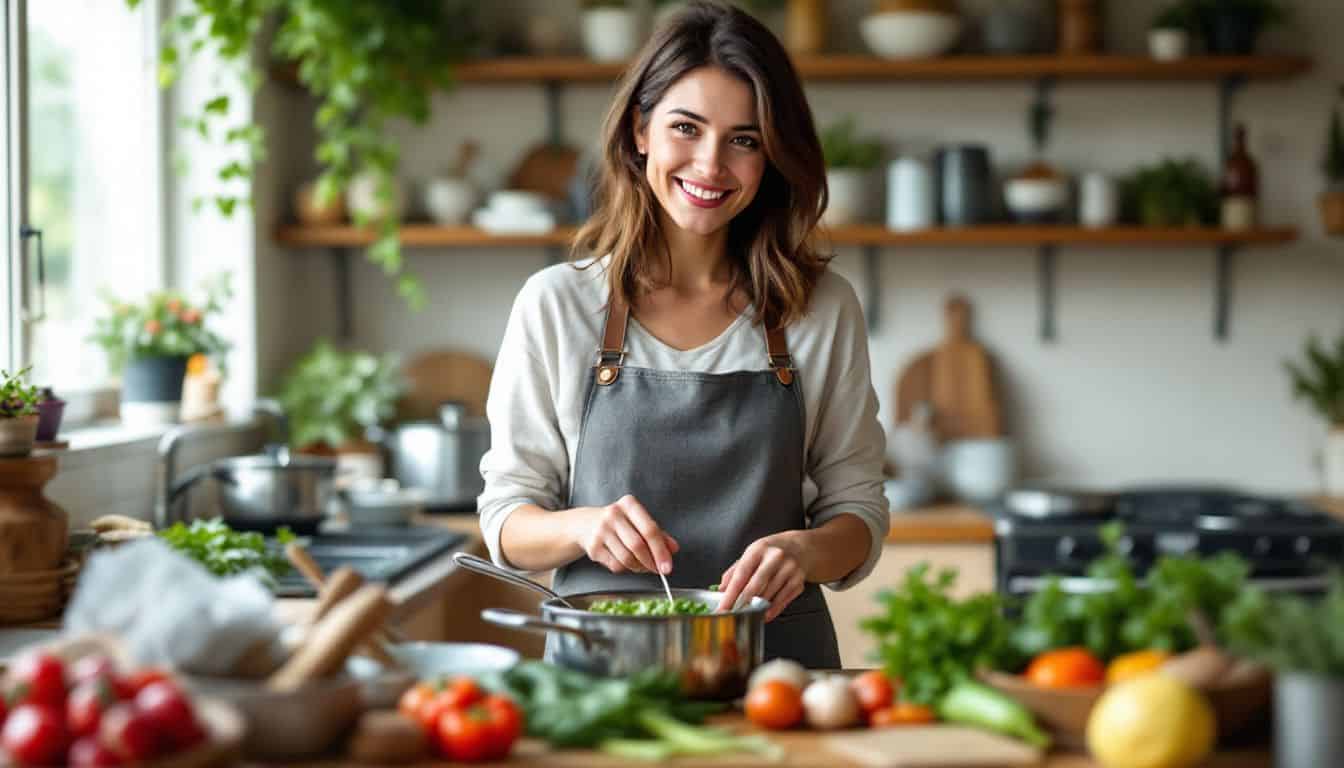
Ready to get your hands dirty? Cooking projects are your ticket to tasty success. Start small with easy dishes, then level up to more complex recipes as you grow confident.
Start with Simple Dishes
Starting simple is key when learning to cook. Let’s dive into some easy dishes that’ll boost your confidence in the kitchen.
- Roasted chicken thighs: These are a great starting point. Season with salt, pepper, and your favorite herbs. Pop them in the oven at 400°F for about 25–30 minutes.
- Rice with an egg and kimchi: This Korean-inspired dish is a breeze. Cook rice, fry an egg, and add store-bought kimchi. It’s a perfect mix of flavors and textures.
- Cheesy pasta: Who doesn’t love pasta? Boil your favorite shape, drain, and toss with butter and grated cheese. Add some black pepper for extra kick.
- Shakshuka: This Middle Eastern dish is simpler than it sounds. Simmer tomatoes and eggs in a pan with spices. Serve with crusty bread.
- Fried rice: Use leftover rice, add some veggies, and an egg. Toss in a hot pan with soy sauce. It’s quick, tasty, and customizable.
- Grilled cheese: Butter two slices of bread, add cheese, and cook in a pan until golden. It’s comfort food at its finest.
- One-pan sausage and veggies: Toss sliced sausage and your choice of veggies on a baking sheet. Drizzle with oil, season, and roast. Dinner’s ready in no time.
Skill-Building Cooking Projects
Now that you’ve got simple dishes under your belt, it’s time to level up. Skill-building cooking projects will push your limits and expand your kitchen know-how. Here’s a list of projects to tackle:
- Master the art of stir-frying. Grab your wok and whip up some fried rice. Play with heat levels and timing to get that perfect char on your veggies.
- Try your hand at homemade pasta. Knead, roll, and cut your own noodles. It’s messy but fun – and the taste beats store-bought any day.
- Roast a whole chicken. Learn to truss, season, and cook a bird to juicy perfection. Bonus: use the leftovers for sandwiches or soup.
- Experiment with Indian spices. Whip up a curry from scratch. Mix your own garam masala for a flavor boost that’ll knock your socks off.
- Bake bread from scratch. There’s nothing like the smell of fresh bread in your kitchen. Start with a simple loaf, then move on to sourdough.
- Perfect your omelet technique. It’s all in the wrist! Practice folding and flipping until you can make a picture-perfect omelet every time.
- Cook a steak to your ideal doneness. Learn to judge meat by touch and temperature. Soon you’ll be grilling like a pro.
- Make your own sushi rolls. It’s easier than you think! Start with simple maki rolls, then work your way up to inside-out rolls.
- Craft a multi-course meal. Plan, prep, and time each dish to come together perfectly. It’s a real test of your kitchen skills.
Ensuring Safety While Cooking
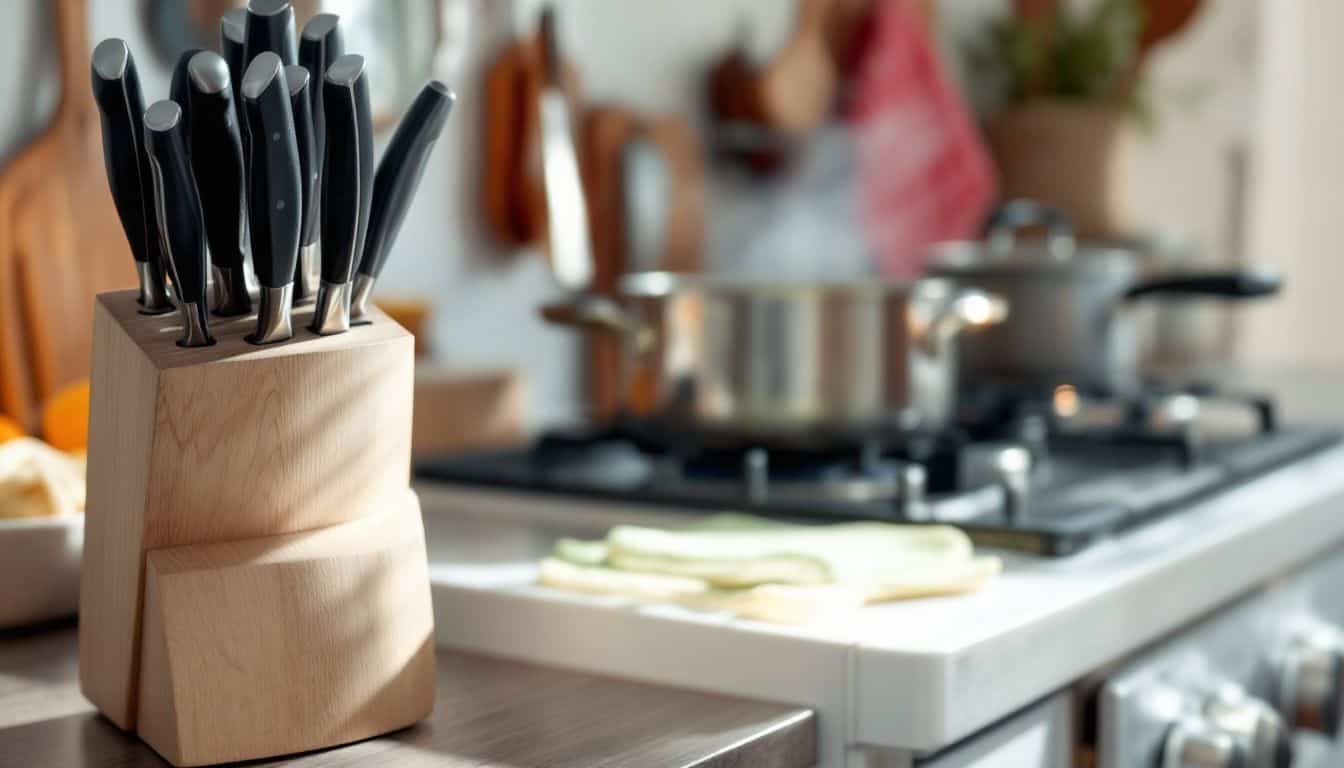
Safety in the kitchen is no joke. It’s crucial to know how to handle knives, hot pans, and food properly – unless you want to end up with a finger in your stir-fry!
Follow Basic Food Safety Rules
Food safety is crucial for every home cook. Let’s dive into some basic rules to keep your kitchen safe and your meals delicious.
- Wash your hands often. Scrub with soap for 20 seconds before and after handling food. This simple step can prevent many foodborne illnesses.
- Keep raw meats separate. Use different cutting boards for meats and veggies to avoid cross-contamination. It’s like giving your foods their own personal space.
- Cook foods to the right temp. Use a food thermometer to check if meats are done. Chicken should hit 165°F, while beef can be 145°F for medium-rare.
- Chill foods quickly. Put leftovers in the fridge within 2 hours. Bacteria love room temp, so don’t give them a chance to party on your food.
- Clean your tools. Wash cutting boards, knives, and counters with hot, soapy water after each use. Think of it as giving your kitchen a mini-spa treatment.
- Thaw foods safely. Use the fridge, not the counter. It might take longer, but it’s worth it to avoid the bacteria buffet.
- Rinse produce. Give fruits and veggies a good wash under running water. No soap needed – just a good scrub will do.
- Check expiration dates. When in doubt, throw it out. It’s better to waste a little food than risk getting sick.
Handle Kitchen Tools Safely
Kitchen tools can be dangerous if not handled with care. Let’s dive into some key tips for keeping yourself safe while cooking up a storm.
- Sharp knives are your friends. Keep them sharp to avoid slips and cuts. A dull blade is more likely to catch and jump, causing accidents.
- Choose the right knife for the job. A paring knife works great for small tasks, while a chef’s knife is better for bigger jobs.
- Use a stable cutting board. Place a damp cloth under it to prevent slipping while you chop.
- Keep your fingers tucked when cutting. Form a “claw” with your hand to protect your fingertips from the blade.
- Be careful with hot pans and pots. Use oven mitts or dry towels to handle them, and always assume they’re hot.
- Turn pot handles away from the stove’s edge. This prevents accidental spills and burns.
- Clean up spills right away. A wet floor is a recipe for slips and falls in the kitchen.
- Unplug small appliances when not in use. This prevents accidental starts and potential injuries.
- Store heavy items on lower shelves. It’s safer and easier to access them without straining or dropping them.
- Use separate cutting boards for raw meats and produce. This simple step helps avoid cross-contamination and keeps your food safe.
People Also Ask
What are the must-have kitchen tools for a beginner cook?
Start with the basics: a sharp knife, cutting board, and liquid measuring cups. Don’t forget a good frying pan with a non-stick surface. A cast iron skillet is a game-changer too. Grab some measuring spoons for teaspoons and tablespoons. A pressure cooker can be a lifesaver for quick meals.
How can I learn basic cooking techniques?
Jump in and try! Start with simple stuff like sautéing veggies or steaming rice. Watch cooking shows or YouTube videos to see pros in action. Practice makes perfect. Try different methods like stir-frying or roasting. Soon, you’ll be whipping up fried rice like a pro!
What are some easy recipes for beginners?
Start with scrambled eggs or a basic pasta dish. Try making a simple casserole or one-pot meal. Indian recipes like dal are great for newbies. Experiment with leafy greens in salads. Don’t shy away from frozen meals – they can teach you about flavors and portions.
How do I choose the right seasonings for my dishes?
Start with the classics: salt, pepper, and garlic powder. Branch out to herbs like basil and oregano. Explore global flavors with curry powder or ginger. Remember, a little goes a long way. Taste as you go and adjust. Your taste buds are your best guide!
What’s the difference between cooking and baking?
Cooking is like jazz – you can improvise. Baking is more like classical music – precision is key. Cooking often involves stovetop work, while baking happens in the oven. Savory dishes are usually cooked, sweet treats are baked. Both are part of the culinary arts, but they require different skills.
How can I explore different cuisines as a beginner?
Start with what you know and branch out. Try Japanese or Cantonese cooking for Asian flavors. Experiment with Indian spices in simple dishes. Don’t be afraid to mix it up – fusion is fun! Cook with friends from different backgrounds. Remember, every expert chef was once a beginner too!
References
https://www.seriouseats.com/basic-starter-kitchen-equipment (2024-09-25)
https://www.epicurious.com/expert-advice/essential-kitchen-tools-for-beginner-cooks-pots-article
https://www.foodnetwork.com/recipes/packages/cooking-from-the-pantry/pantry-essentials-checklist
https://wingingitonthehomestead.com/pantry-staples-you-need-to-start-making-from-scratch-meals/
https://www.bhg.com/recipes/how-to/cooking-basics/cooking-techniques-everyone-should-master/ (2024-09-10)
https://medium.com/@larmenio/recipe-decoding-words-into-action-e7a3737d928d
https://www.buzzfeed.com/jesseszewczyk/common-cooking-mistakes-how-to-solve (2019-03-10)
https://www.themountainkitchen.com/cooking-mistake-overcrowded-pan/ (2015-09-15)
https://foodal.com/knowledge/how-to/common-cooking-mistakes/
https://www.leithsonline.com/post/how-to-be-a-better-cook
https://www.escoffier.edu/blog/recipes/4-advanced-cooking-methods-for-every-chef/ (2015-12-28)
https://www.readthistwice.com/lists/best-cookbooks-for-beginners
https://www.delish.com/cooking/g32146845/online-cooking-classes/ (2021-04-22)
https://www.foodsafety.gov/keep-food-safe/4-steps-to-food-safety (2023-09-18)
